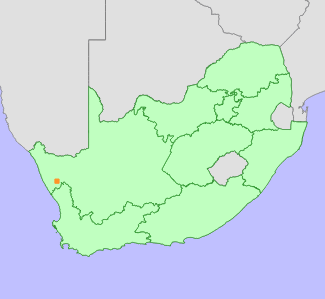|
Scientific Name | Amphithalea obtusiloba (Granby) A.L.Schutte |
Higher Classification | Dicotyledons |
Family | FABACEAE |
Synonyms | Coelidium obtusilobum Granby |
National Status |
Status and Criteria | Endangered D |
Assessment Date | 2008/02/15 |
Assessor(s) | N.A. Helme & D. Raimondo |
Justification | Population consists of less than 100 plants. Potentially threatened by too frequent fire and overgrazing. |
Distribution |
Endemism | South African endemic |
Provincial distribution | Northern Cape |
Range | Endemic to the Kamiesberg. |
Habitat and Ecology |
Major system | Terrestrial |
Major habitats | Kamiesberg Granite Fynbos |
Description | Rocky granitic slopes, 1500 m. |
Threats |
| This reseeder is potentially vulnerable to too frequent fires. Plants prefer sites protected from fire, and fires do not appear to be negatively affecting the population at present. This is also a palatable species grazed by donkeys and rock hyraxes, but grazing is not as severe as to cause a decline in the population at present. |
Population |
Known from a single subpopulation of less than 100 plants. Repeated searches failed to locate any other subpopulations.
|
Population trend | Stable |
Assessment History |
Taxon assessed |
Status and Criteria |
Citation/Red List version | | Amphithalea obtusiloba (Granby) A.L.Schutte | EN D | Raimondo et al. (2009) | | Coelidium obtusilobum Granby | Endangered | Hilton-Taylor (1996) | |
Bibliography |
Hilton-Taylor, C. 1996. Red data list of southern African plants. Strelitzia 4. South African National Botanical Institute, Pretoria.
Raimondo, D., von Staden, L., Foden, W., Victor, J.E., Helme, N.A., Turner, R.C., Kamundi, D.A. and Manyama, P.A. 2009. Red List of South African Plants. Strelitzia 25. South African National Biodiversity Institute, Pretoria.
|
Citation |
| Helme, N.A. & Raimondo, D. 2008. Amphithalea obtusiloba (Granby) A.L.Schutte. National Assessment: Red List of South African Plants version 2024.1. Accessed on 2025/10/14 |
 Comment on this assessment
Comment on this assessment


